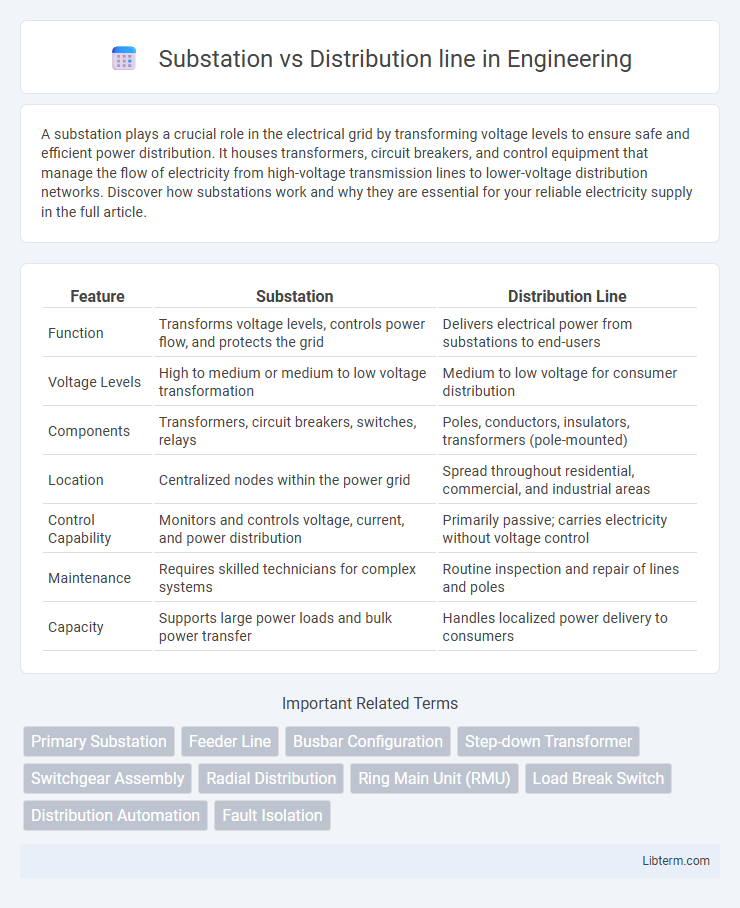A substation plays a crucial role in the electrical grid by transforming voltage levels to ensure safe and efficient power distribution. It houses transformers, circuit breakers, and control equipment that manage the flow of electricity from high-voltage transmission lines to lower-voltage distribution networks. Discover how substations work and why they are essential for your reliable electricity supply in the full article.
Table of Comparison
| Feature | Substation | Distribution Line |
|---|---|---|
| Function | Transforms voltage levels, controls power flow, and protects the grid | Delivers electrical power from substations to end-users |
| Voltage Levels | High to medium or medium to low voltage transformation | Medium to low voltage for consumer distribution |
| Components | Transformers, circuit breakers, switches, relays | Poles, conductors, insulators, transformers (pole-mounted) |
| Location | Centralized nodes within the power grid | Spread throughout residential, commercial, and industrial areas |
| Control Capability | Monitors and controls voltage, current, and power distribution | Primarily passive; carries electricity without voltage control |
| Maintenance | Requires skilled technicians for complex systems | Routine inspection and repair of lines and poles |
| Capacity | Supports large power loads and bulk power transfer | Handles localized power delivery to consumers |
Introduction to Substations and Distribution Lines
Substations transform voltage levels between high transmission voltages and lower distribution voltages crucial for delivering electricity to consumers. Distribution lines carry the lower voltage electricity from substations to homes and businesses, facilitating local power distribution within communities. Effective integration of substations and distribution lines ensures reliable and efficient electrical power delivery across the grid.
Definition and Purpose of Substations
Substations are critical components in the electrical power system, acting as nodes that transform voltage levels and control power flow between generation sources and distribution networks. They serve the purpose of stepping down high-voltage electricity from transmission lines to lower voltages suitable for distribution to homes and businesses. Unlike distribution lines that carry electricity directly to end-users, substations manage and regulate the voltage, ensuring efficient and reliable power delivery.
Definition and Purpose of Distribution Lines
Distribution lines are the final stage in the electric power delivery system that transport electricity from substations to residential, commercial, and industrial consumers. Unlike substations, which transform voltage levels for efficient transmission and distribution, distribution lines ensure safe and reliable delivery of electricity at usable voltages to end-users. These lines play a crucial role in maintaining continuous power flow and enabling local energy distribution within communities.
Key Components of Substations
Substations contain key components such as transformers, circuit breakers, isolators, and busbars that regulate voltage levels and control power flow between generation sources and distribution lines. These components ensure reliability and safety by isolating faults and managing power quality before electricity reaches distribution lines. Distribution lines primarily transport electricity from substations to end users, lacking the complex voltage regulation and protection equipment found in substations.
Key Components of Distribution Lines
Distribution lines consist primarily of conductors, transformers, voltage regulators, and protective devices that ensure efficient power delivery from substations to end users. Insulators support and isolate energized conductors, while poles or underground conduits provide structural support and routing. Effective coordination of these components is essential for maintaining voltage levels and minimizing power loss in the distribution network.
Differences in Functionality
Substations primarily serve as nodes for voltage transformation and control, converting high-voltage electricity from transmission lines into lower voltages suitable for distribution. Distribution lines, on the other hand, are responsible for delivering electricity from substations directly to consumers, maintaining consistent voltage levels suitable for residential, commercial, and industrial use. While substations include equipment such as transformers, circuit breakers, and switchgear for protection and regulation, distribution lines consist mainly of conductors and poles or underground cables designed to transport electricity over shorter distances.
Role in the Electrical Power System
Substations play a crucial role in the electrical power system by transforming voltage levels, regulating power flow, and facilitating the control and protection of the grid. Distribution lines deliver electricity from substations directly to consumers, distributing low-voltage power suitable for residential, commercial, and industrial use. Together, substations and distribution lines ensure efficient transmission and reliable delivery of electrical energy across the network.
Safety Considerations: Substations vs Distribution Lines
Substations present higher safety risks due to high voltage equipment, requiring restricted access, specialized protective gear, and robust grounding systems to prevent electrical hazards. Distribution lines, while operating at lower voltages, pose safety challenges related to exposure to weather, physical contact, and tree interference, necessitating regular inspections and vegetation management. Both infrastructures demand adherence to strict safety standards to protect workers and the public from electric shock and outages.
Maintenance Requirements and Challenges
Substations require specialized maintenance including transformer oil testing, switchgear inspections, and protective relay calibrations to ensure reliable operation under high voltage conditions. Distribution lines demand routine vegetation management, pole integrity assessments, and conductor inspections to prevent outages and maintain power quality. Both systems face challenges such as weather-related damage and equipment aging, but substations involve more complex technical diagnostics while distribution lines require extensive physical accessibility.
Choosing Between Substation and Distribution Line Solutions
Choosing between a substation and a distribution line depends on factors such as power capacity, reliability, and geographic area served. Substations are ideal for converting voltage levels and managing large-scale power distribution, ensuring efficient energy delivery over long distances. Distribution lines, on the other hand, are cost-effective for local power dissemination, providing direct electricity access to residential and commercial consumers within a smaller radius.
Substation Infographic

 libterm.com
libterm.com